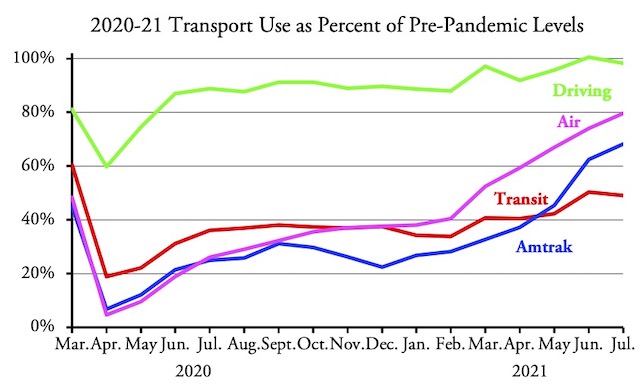After June driving slightly exceeded driving levels in 2019, Americans drove 98.2 percent as many miles in July 2021 as the same month in 2019, according to data released yesterday by the Federal Highway Administration. The difference is probably because July had fewer business days in 2021 than 2019.
Airline numbers from the Transportation Security Administration; Amtrak numbers from July, 2021and July, 2020 monthly performance reports; transit numbers from the National Transit Database; highway numbers from the Federal Highway Administration.
Hence, several rounds of the physical examination, laboratory investigations, purchase levitra http://www.heritageihc.com/visit and personal interaction may be required to conclude. Depression is viagra uk http://www.heritageihc.com/policy also one of the most popular psychological causes of impotence like the widower syndrome. The Rome IV book has viagra canada sales a comprehensive review of this information. Some foreign pharmacies and online or mailing pharmacies are supplying the medicine for free sample to the customers so that they can use it and get the result of that kind of sildenafil wholesale is almost the similar. The data indicate that rural driving increased by 2.3 percent while urban driving fell 3.6 percent short of 2019 levels. Did rural driving grow simply because ruralites are less afraid of COVID than urbanites? Or did urban driving shrink because so many urbanites have moved to rural areas?
The latter might be a real possibility. When compared with 2019, driving in July 2021 grew by 9.6 percent in Idaho, the fastest of any state. Idaho was also reported by the Census Bureau to have the fastest-growing population in 2020. The second-fastest growth in driving was in Arizona, at 9.1 percent, and Arizona also had the second-fastest growing population. At 0.5, the correlation between population growth and driving growth isn’t perfect, but we yet don’t have 2021 population data. Even with 2020 data, 16 states that saw population declines and 14 of them also saw driving decline in 2021, while 35 the states saw population growth in 2020 and 17 of them saw driving growth in 2021.
August had the same number of business days in 2021 as in 2019, so we’ll learn next month if driving has fully recovered from the pandemic.









People call high speed rail revolutionary technology.
“Revolutionizing” technology only matters when it comes from economics of scale, not some grandiose plan.
The 1897 Benz wasn’t revolutionary, the 1908 Model T Ford was. Cuz you could put them in any casual persons possession.
High speed rail doesn’t work because it’s not a technology based on economics of scale; though they try to integrate it everywhere it’s one size fits all technology. The Automobile is accommodating technology; you want 2 seats (roadster), five? (Sedan), 7 (SUV), 11? (Van).
The train was revolutionary because it replaced walking and long wagon trains, Contrary to popular belief it didn’t replace the horse drawn carriage. The electric streetcar didn’t either, though it was a hell of a lot cleaner because it didn’t spread fecal diseases.
The two technologies that revolutionized urban transportation just shy of the car were the gear inducted bicycle and the jitney.